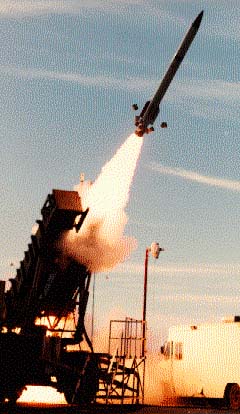Strategic Defense Initiative
File:Reagan SDI Speech 1983.ogv
U.S. missile defense program
Strategic Defense Initiative
The Strategic Defense Initiative (SDI) was a proposed missile defense system intended to protect the United States from attack by ballistic missiles, which could be launched by the Soviet Union or other adversaries. The initiative was announced by President Ronald Reagan on March 23, 1983. The ambitious project aimed to develop a sophisticated anti-ballistic missile system that would prevent missile attacks by intercepting and destroying them in space.
Background[edit | edit source]
During the Cold War, the threat of nuclear warfare between the United States and the Soviet Union was a significant concern. The doctrine of Mutual Assured Destruction (MAD) was based on the idea that both superpowers possessed enough nuclear weapons to destroy each other, thus deterring either side from initiating a conflict. However, the development of a missile defense system like SDI was seen as a way to potentially neutralize the threat of a nuclear attack.
Development[edit | edit source]
The SDI program was managed by the Strategic Defense Initiative Organization (SDIO), which was established in 1984. The initiative explored various technologies, including ground-based and space-based systems, to intercept incoming missiles. Some of the proposed technologies included:
The program faced numerous technical challenges and criticisms. Critics argued that the technology required for SDI was not feasible with the existing scientific knowledge and that the initiative could escalate the arms race.
Impact and Legacy[edit | edit source]
The Strategic Defense Initiative had a significant impact on the Cold War dynamics. It is often credited with putting pressure on the Soviet Union, contributing to its eventual dissolution. The high costs associated with countering SDI may have strained the Soviet economy, accelerating the end of the Cold War.
In 1993, the SDI program was officially renamed the Ballistic Missile Defense Organization (BMDO) and shifted focus towards more practical missile defense systems. Elements of SDI research have influenced modern missile defense initiatives, such as the Ground-based Midcourse Defense (GMD) system.
Related Pages[edit | edit source]
- Cold War
- Mutual Assured Destruction
- Ballistic Missile Defense Organization
- Ground-based Midcourse Defense
- Ronald Reagan
- Soviet Union
Categories[edit | edit source]
Search WikiMD
Ad.Tired of being Overweight? Try W8MD's physician weight loss program.
Semaglutide (Ozempic / Wegovy and Tirzepatide (Mounjaro / Zepbound) available.
Advertise on WikiMD
|
WikiMD's Wellness Encyclopedia |
| Let Food Be Thy Medicine Medicine Thy Food - Hippocrates |
Translate this page: - East Asian
中文,
日本,
한국어,
South Asian
हिन्दी,
தமிழ்,
తెలుగు,
Urdu,
ಕನ್ನಡ,
Southeast Asian
Indonesian,
Vietnamese,
Thai,
မြန်မာဘာသာ,
বাংলা
European
español,
Deutsch,
français,
Greek,
português do Brasil,
polski,
română,
русский,
Nederlands,
norsk,
svenska,
suomi,
Italian
Middle Eastern & African
عربى,
Turkish,
Persian,
Hebrew,
Afrikaans,
isiZulu,
Kiswahili,
Other
Bulgarian,
Hungarian,
Czech,
Swedish,
മലയാളം,
मराठी,
ਪੰਜਾਬੀ,
ગુજરાતી,
Portuguese,
Ukrainian
Medical Disclaimer: WikiMD is not a substitute for professional medical advice. The information on WikiMD is provided as an information resource only, may be incorrect, outdated or misleading, and is not to be used or relied on for any diagnostic or treatment purposes. Please consult your health care provider before making any healthcare decisions or for guidance about a specific medical condition. WikiMD expressly disclaims responsibility, and shall have no liability, for any damages, loss, injury, or liability whatsoever suffered as a result of your reliance on the information contained in this site. By visiting this site you agree to the foregoing terms and conditions, which may from time to time be changed or supplemented by WikiMD. If you do not agree to the foregoing terms and conditions, you should not enter or use this site. See full disclaimer.
Credits:Most images are courtesy of Wikimedia commons, and templates, categories Wikipedia, licensed under CC BY SA or similar.
Contributors: Prab R. Tumpati, MD






